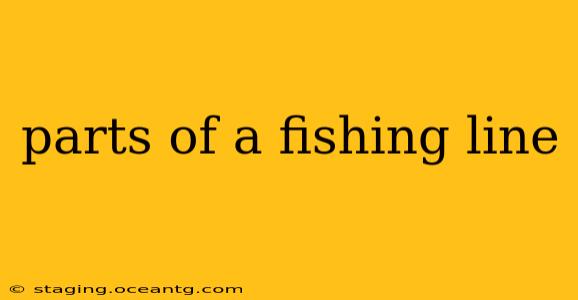Fishing line, seemingly simple, is a complex piece of equipment with various components impacting its performance and longevity. Understanding these parts is crucial for anglers of all skill levels, allowing for better line selection and ultimately, more successful fishing trips. This guide will break down the key aspects of fishing line, answering common questions anglers often have.
What are the main components of fishing line?
While seemingly straightforward, fishing lines have several key components affecting their overall properties. These include the base material (monofilament, fluorocarbon, braided), the diameter (measured in pounds test or millimeters), and the coatings or treatments applied to enhance performance. The manufacturing process itself also heavily influences the line's characteristics. We’ll delve deeper into these aspects below.
What is monofilament fishing line made of?
Monofilament line, the most common type, is typically made from nylon. This synthetic polymer provides a balance of strength, flexibility, and affordability. The manufacturing process involves extruding molten nylon through a die to create a single continuous filament. Different manufacturing techniques and additives can affect the line's characteristics, such as its knot strength, abrasion resistance, and memory (tendency to retain its shape).
What is fluorocarbon fishing line made of?
Fluorocarbon line, a premium option, is made from a fluoropolymer resin. This material offers superior abrasion resistance, low visibility in water (due to its refractive index close to water), and high knot strength compared to nylon. It's more expensive but often preferred by anglers targeting wary fish or fishing in environments with abrasive structure.
What is braided fishing line made of?
Braided fishing line is constructed from multiple, highly-strength fibers, typically high-density polyethylene (HDPE), tightly interwoven to form a strong, thin diameter line. This construction gives braided line exceptional strength and sensitivity, allowing anglers to detect subtle bites and cast further distances. However, it can be more prone to cuts and abrasions than monofilament or fluorocarbon.
What are the different types of fishing line?
Beyond the base materials (monofilament, fluorocarbon, braided), fishing lines come in various types designed for specific fishing applications. These include:
- Coated lines: These lines have an added coating to improve abrasion resistance, smoothness, or casting performance.
- Superlines: A term often used interchangeably with braided line, emphasizing its superior strength-to-diameter ratio.
- Specialty lines: These lines are tailored for specific techniques or target species, such as fly fishing lines or lines with specific colorations for better visibility or invisibility.
How is the diameter of fishing line measured?
Fishing line diameter is usually expressed in two ways:
- Pound test (lb test): This refers to the amount of weight the line can theoretically hold before breaking. A higher pound test indicates a thicker diameter.
- Millimeters (mm): This provides a direct measurement of the line's diameter, offering a more precise comparison between different brands and types.
What are the advantages and disadvantages of each type of fishing line?
Each type of fishing line has its advantages and disadvantages:
Monofilament:
- Advantages: Affordable, relatively strong, easy to tie knots.
- Disadvantages: Stretches under load, visible in water, less abrasion-resistant.
Fluorocarbon:
- Advantages: Low visibility, high abrasion resistance, high knot strength.
- Disadvantages: Expensive, stiffer than monofilament, can be difficult to tie knots.
Braided:
- Advantages: Very strong, thin diameter for long casts, highly sensitive.
- Disadvantages: Prone to abrasion, can be difficult to knot, not as forgiving to knots.
This comprehensive guide provides a detailed overview of the various parts and types of fishing lines. Understanding these nuances will empower you to make informed decisions and enhance your fishing experience. Remember to consider the specific demands of your fishing style and target species when choosing the right fishing line for your needs.
